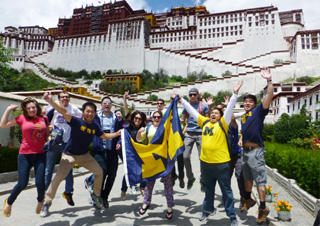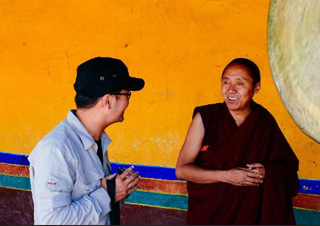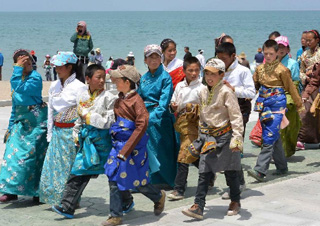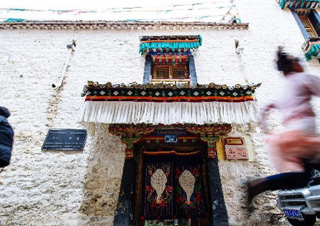14 Days Nepal-Mount Kailash Trekking Tour
Tour Type: Private Tour: Flexible Travel Date & Travel Routes
Guide & Driver: Chinese-English-speaking guide & air-conditioned
Tour Highlights:
B-- Breakfast L-- Lunch D-- Dinner
-
Day 1 Kathmandu - Gyirong / 185km, About 7hrs' Driving
After breakfast, our local guide will pick you up, then drive to Gyirong Port (altitude: 1800m) at the border. Though the distance is only about 160km, it takes more than 6 hours to drive to Gyirong Port from Kathmandu because the road is narrow and bumpy. During the rainy season, the road is muddy and may be closed for the landslides.
After arriving at Gyirong Port, you will check through the custom, and be picked up by your Tibetan tour guide, then drive about 25km to today's destination Gyirong Town.
Accommodate at Gyirong Town(altitude: 2600m).
Tip of today: Make sure your Group Visa, Tibet Entry Permit and Border Pass are issued before departing to Tibet.
Accommodation: Overnight in Gyirong
-
Day 2 Gyirong Town - Saga / 170km, About 4.5hrs' Driving
On this day, you drive about 4.5 hours (170km) to Sagar County from Gyirong Town. It is a rather short trip but scenery is good as well. The altitude of Saga County is around 4600m. After arrival at the town, spend some time acclimatize yourself to the high altitude here. Avoid strenuous activities.
Tip of Today: you can buy some food and drinks in the town of Saga County. After leaving Saga, there won't be bigger town for supply.
Accommodation: Overnight in Saga
-
Day 3 Saga - Darchen / 490km, About 9hrs' Driving ( B )
After breakfast, you have to take another long driving about 550km from Saga to Darchen (4,575m), a small village located as the starting point of the walking kora of the holy Mount Kailash. During the auspicious pilgrimage times, Darchen will be flooded with Pilgrims with hundreds of tents all over the small village.
Accommodate at local guesthouse in Darchen.
Accommodation: Overnight in Darchen
-
Day 4 Darchen - Dirapuk ( B )
Trekking Time: 5-6 hrs, 20km
Trek from Darchen (4,560m) to Dirapuk Monastery (4,750m). The trek is a gradual walk in the clockwise circuit at the average altitude of more than 4,700 meters. You will be accompanied by many local Buddhist pilgrims also walking the same kora. If you meet people who come the anti-clockwise direction, don't be surprise, they are Bon pilgrims. You will stop at the Tamdin (4,780m) for lunch and hot water supply. Then keep trekking 4km to the final destinations of today - Dirakpuk Monaster. This section of trekking boasts some of the best scenery of the entire kora.
Accommodate at Dirapuk guesthouse.
Accommodation: Overnight in Dirapuk
-
Day 5 Trek from Dirapuk to Zutulpuk
Trekking Time: 6-7 hrs, 18km
Trek from Dirapuk Monastery uprising 762 meters at altitude to Zutulpuk Monastery by crossing Drolma-la Pass (5,630m) before quickly descending to Dzutul-puk monastery (Dzutul-puk means "magical cave" in Tibetan).
Stay overnight at the tent guesthouse of monastery.
Accommodation: Overnight in Zutulpuk
-
Day 6 Zutulpuk - Darchen - Lake Manasarovar
Trekking Time: 3 hrs,11km
Wake up in the holy sunrise of Mount Kailash, after breakfast, you will trek back to Darchen. Todays' trekking is leisure and relaxing, which can be done in 3 ~ 4 hours. On route, explore the meditation cave of Milarepa, the famous Buddhist master and Yoga meditator. Surrounding the cave are many temples and shrines.
Once you exist from the valley, your driver will pick you up and transfer to visit the famous holy lake Manasarovar. Like Mount Kailash, Lake Manasarovar is a holy place of pilgrimage, attracting religious people from India, Nepal, the neighboring countries and Tibet. Believers bath in the Manasarovar Lake and drink its water are believed to cleanse all sins. Every summer, pilgrims from Tibet, India and Nepal cluster to make circumambulation and bathe in the lake. After that, they will return home and bring some samples of the holy water to family and friends as precious gifts.
Stay over night in a local guest house near the Lake Manasarovar.
Accommodation: Overnight in Lake Manasarovar
-
Day 7 Manasarovar - Payang - Saga
Drive through the windswept territory passing many villages and camps of Yak herders, and back to Saga. There are many opportunities to take great pictures!
Accommodation: Overnight in Saga
-
Day 8 Saga - Mount Everest / 450km, About 9hrs' Driving ( B )
Today, you will leave Shigatse for the word's highest peak - Mount Everest. Though being a long driving of about 7 hours, but the views along the road are stupendous. In clear days, you can see the clear face the Himalaya range including several famous peaks over 8,000 meters, such as Makalu, Lhotse, Gyachung and Cho Oyu and enjoy the beautiful view of Pekutso Lake. When you finally get to the Rongbuk Monastery (altitude: 4,980m), and get the first sight of the mighty Everest, you will immerse in a solemn ethereal mood and find all the efforts you have made along the long way are not in vain. Located about 5100 meters above the sea level, Rongbuk Monastery is the highest monastery in the world. It is the best location to take some great photos of the front face of Mount Everest. The rest of today is free for you visit the Rongbuk Monastery and explore surrounding landscape.
Accommodation: if you visit Mount Everest during off season (November to April), you will accommodate at Rongbuk Guest House near the Rongbuk Monastery; if you visit Mount Everest during the peak season (May to October), you will accommodate at the Tibetan Tents Camp which is about 4km further from Rongbuk Monastery. Please note that the accommodation at both places is very simple and basic, only dorm beds with communal squat toilets are available. Duvets, heated blankets and hot water will be provided, and you are suggested to bring your own sleeping bag and toilet paper. There is no running water, sinks or showers. The dining room just offer basic breakfast and dinner without menu. Remember to dress warmly all the time.
Tips of today: 1) prepare more food and drinks for long driving; 2) bring a warm and thick coat for low temperature in Everest; 3) avoid strenuous activity to prevent from high altitude sickness.
Accommodation: Overnight in Mount Everest
-
Day 9 Mount Everest - Shigatse / 350km, About 7hrs' Driving
Wake up early to enjoy the marvelous sunrise on the peak of the world. Then drive about 4km further to Tibetan Tents Camp (altitude: 4900m) where you can enjoy a closer view of Mount Everest.
The top part of the Mount Everest is always covered by snow all the year round, and when the sun shines on the mountain, the peak is like a giant white pyramid, which is one of the most famous sceneries of Mount Everest. In bright days, you can also see a wisp of cloud hanging above the top of Mount Everest. It flies eastward in the fast western wind just like a flapping flag. This unique phenomenon is the spectacular “Cloud Flag”. The cloud will change from surging waves into a thin cooking smoke or from galloping steeds into the mysterious veil of a goddess.
Till now your Mount Everest adventure is about to end. The rest of today is to drive back to Shigatse City.
Accommodate in Shigatse City.
Tips of today: 1) to protect the environment of Mount Everest, currently Everest Base Camp is not open for tourists – the Everest landscape can be enjoyed at Rongbuk Monastery and Tibetan Tent Camp as well. The base camp marker, a tablet reading “Mt. Qomolangma Base Camp” has been transferred to the Tibetan Tent Camp. You are suggested to take a photo at the marker to commemorate your wonderful adventure tour; 2) the sunrise usually starts around 6:30 am to 7am on Mount Everest; 3) keep warm all the time.
Accommodation: Overnight in Shigatse
-
Day 10 Shigatse - Gyantse / 95km, About 2.5hrs' Driving ( B )
Today, before driving to Gyantse from Shigatse, take a visit to the official seat of Panchen Lama - Tashilhunpo Monastery (altitude: 3,800m)which is also the largest and most influential Gelug Monastery in Shigatse prefecture. Here you will see a giant statue of Future Buddha, the largest one of its kind on earth ( 26.2 meters high and 11.5 meters wide ), decorated with precious pearls, turquoises, corals and ambers.
After arriving at Gyantse, go to visit the mysterious Palcho Monastery (altitude: 4,040m). The monks and tradition of three important sects of Tibetan Buddhism - Sakyapa, Zhalupa and Gelukpa, peacefully coexist in this monastery. Its Kumbum, which is 35 meters high and has 76 small chapels with hundreds images of Kriyatantras , is believed to be the largest such structure in Tibet. Finishing the visit in Palcho, go to take some photos of the Gyantse Dzong Fortress on which the Tibetan army used to fight against the British army's invasion during the early 20th century. It is a very impressive fortress with typical Tibetan palace architecture style which is inherited from Yumbulagang Palace - The First Palace of Tibet.(Gyantse Dzong Fortress now is closed for maintenance. Tourists cannot climb up to the top, but still can enjoy its magnificent appearance from the square at the foot of the Dzong Hill.)
Accommodate at Gyantse Town.
Accommodation: Overnight in Gyantse
-
Day 11 Gyantse - Lhasa / 260km, About 6hrs' Driving ( B )
After breakfast, you will going to visit a very special site where you can learn about the living condition and tradition of old Tibet - Pala Manor (altitude: 4,040m). Located in a Tibetan village about 4km southwest from Gyantse city, Pala Manor is the only aristocratic manor preserved well in Tibet, and used to be the private manor of Pala families since 17th century. The aristocratic and the serfs both lived in the manor but completely different life. The aristocratic didn't need to work, lived in bright, large and luxury rooms, used costly furnitures and imported luxuries, such as OMEGA watch, LV purse, wine, etc. While the serfs lived in dark crude room in yards, got paid little but did all the labouring works. Fortunatly, the house, relics in the rooms are still remain the same as they used to be.
Leaving Gyantse, you will heading to the capital city of Tibet - Lhasa. After a driving of about 75km, you will see the imposing Karola Glacier (altitude: 5,045m)towering aloft on the right side of the road. Keeping driving for a while, you will get to Yamdrok Lake (altitude: 4,400m). As the largest fresh lake in the northern of the Himalaya Mountains, it spreads about 675 square meters from south to north, like an eardrop lying in the arms of snow-capped giant mountains. Viewing from a distance, you can see fertile pastures full of yaks and sheep, and some small Tibetan villages along the lakeshore.
Accommodation: Overnight in Lhasa
-
Day 12 Lhasa ( B )
Start today’s Lhasa exploration with an exciting visit to the landmark - Potala Palace which is regarded as one of the most beautiful architectural building in the world. You will climb up the palace along the zigzag stone paths with white-and-red walls to the top of the palace where you can not only appreciate the exotic Tibetan-style architecture, but also get a great view of Lhasa’s urban areas, then walk into the inner space of Potala Palace to explore the stately chapels and learn about the history of the palace.
Continuing your exploration, you will then get to Jokhang Templewhich is considered as the spiritual heart of Tibetan Buddhism. Each day, there are thousands of pilgrims coming from different places in Tibet to the temple to worship to the Buddha. This temple is also known as the “house of Buddha” because it keeps the precious Jowo Rinpoche, the life-sized (5 foot/1.5m) image of the Shakyamuni at the age of 12. The last site for today’s exploration is the famous Barkor Street. It is a circular and wide street encircling the Jokhang Temple. The local people like to walk on the street for several circles usually in the late afternoon as a daily tradition of pilgrimage. The street also has many shops selling a wide variety of traditional Tibetan goods, religious items and handcrafts.
Tips of today: 1) there are 1,080 steps up to climb to the top of Potala Palace, so don’t walk in a rush, which may cause high altitude sickness; 2) taking photos is not allowed inside the palace; 3) today you will be mainly outside, please bring some water, a hat, sun cream, and sun glasses with you.
Accommodation: Overnight in Lhasa
-
Day 13 Lhasa ( B )
After breakfast, you will firstly go to visit the beautiful Norbulingka which used to be the former summer palace of Dalai Lamas in the ancient time, and now is a public park. It is famous for its Potrang, the private palaces of former Dalai lamas with grandiose Tibetan architecture style. Next, drive several kilometers to the western outskirts of Lhasa to visit Drepung Monastery. Drepung, in Tibetan, means “prosperity”. Since its establishment, Drepung Monastery has always been one of the most important Buddhist monasteries in Tibet. In its heyday, there were more than 10,000 monks lived and studied in the monastery. Throughout its history, many important and famous Tibetan leaders used to study here, especially the Dalai Lamas. So Drepung Monastery is also respectfully known as the “Mother School of Dalai Lamas”.
In the afternoon, you will be taken to another famous monastery in Lhasa - Sera Monastery. It is famous for the spectacular “Buddhism Debating”. As a daily routine, the monks gather in a courtyard, and debate on the Buddhist doctrines with supplemented gestures, which is thought to be helpful to facilitates better comprehension of the Buddhist philosophy to attain higher levels of study. After enjoying the "Buddhism Debating", you will be transferred back to the city. The rest time is your own free time to rest.
The Etiquette of Visiting Monastery: 1) you shouldn’t wear short and uncover shoulders; 2) taking off your sunglasses and hat before entering the chapels; 3) taking photos is usually not allowed inside the chapels.
Accommodation: Overnight in Lhasa
-
Day 14 14 Lhasa Departure ( B )
Today is free for you until your tour guide transfer you to the airport in time for your flight or drop you off at Lhasa train station.
Tips of today: 1) please pack your luggage carefully, especially for small things like camera charger, power adaptor, mobile phone, phone charger, wallet and towel; 2) if your flight is arranged in the afternoon, please make sure you check out the hotel before 12pm.
Accommodation: Overnight in Lhasa
- All necessary Tibet Travel Permit. (Including Tibet Entry Permit, Alien Travel Permit, Boarder Pass
- Private professional English-Speaking local tour guide
- Licensed Vehicle with experienced driver
- Airport (or train)pick up and drop off
- Accommodation listed in the itinerary
- Breakfast provided by the hotel
- Tourists Accident/Casualty Insurance
- A container of Oxygen for emergency use
- All taxes, fees and handling charges
- Lodging and meal allowance to the guide & driver
- Reservation fee for visiting Potala Palace
- 2 bottles of drinking water per person per day
- Meals not specified in the itinerary (All lunches & dinners)
- All Entrance tickets to the sightseeing places
- Flight/Trian tickets in and out of Tibet
- Personal expenses such as laundry, drink, fax, telephone call, optional tour activities, etc.
- Any losses incurred from the force majeure factor like government control, natural disaster etc.
- Tips to the guide & driver ( Tips is not required but expected)
- Single room supplement
Why Travel With Us.
-
Bigger savings on transportation, accommodation, tickets and tour packages.
Scoring a massive discount on early-bird booking. -
24/7 professional customer services provided by trained travel consultants
One-stop support for travel documents application, tickets booking and problem solving through the tour- 100% train tickets guaranteed in the past 10 years.
Over 60% of regular customers and returning customers come back to travel with us. -
Genuine touch and taste of the local sceneries, culture and food.
Non-shopping private trips of exploring and discovering an authentic Tibet. -
Experienced drivers & tour guides to ensure your tour to be safe and fun.
Custom tailored package to meet your needs across a wide range of levels travelling.
Complete and considerate returns, refund and exchange policies help you to prevent and minimize travel risk.
Itineraries you may also like:
-
 10 Days Eastern Tibet Tour to Explore the Natural Beauty
10 Days Eastern Tibet Tour to Explore the Natural Beauty
-
 16 Days Gama Valley Trekking Tour
16 Days Gama Valley Trekking Tour
-
 10 Days Nyingchi EBC Namtso Tour
10 Days Nyingchi EBC Namtso Tour
-
 10-Day Nepal and Bhutan Package
10-Day Nepal and Bhutan Package
-
 11 Days Nyingchi Peach Blossom Festival Tour
11 Days Nyingchi Peach Blossom Festival Tour
-
 9 Days Train Tour from Chengdu to Lhasa
9 Days Train Tour from Chengdu to Lhasa
-
 16 Days Tibet to Xinjiang Overland Trip
16 Days Tibet to Xinjiang Overland Trip
-
 9 Days Classic Trip to EBC with Namtso Lake
9 Days Classic Trip to EBC with Namtso Lake
-
 9 Days Lhasa - Tsedang - Shigatse Cultural Tour
9 Days Lhasa - Tsedang - Shigatse Cultural Tour
Quick Question
(age 12+):
- 1
- 2
- 3
- 4
- 5
- 6
- - Title -
- Mr
- Ms
Why Choose Us
- Reply within 24 hours
Personalized trip proposal
Price quote
- 100% tailor-made trip
Satisfaction guaranteed trip plan
Flexible travel date
- Worry-Free vacation
Private guide & car
24/7 customer care








 Data in submission...
Data in submission...


